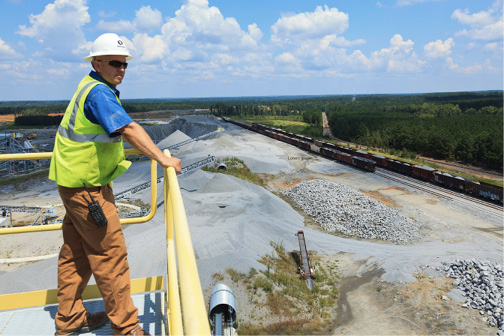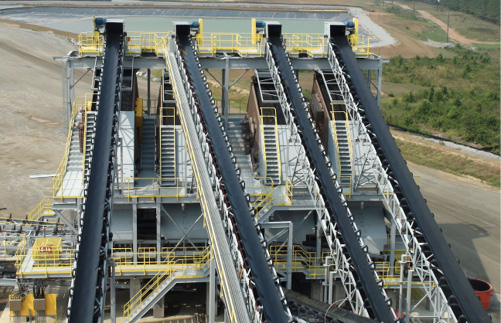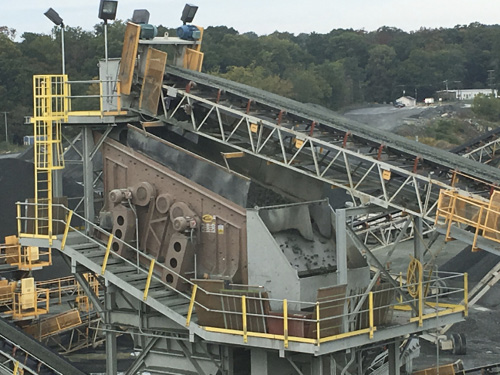For Aggregates Producers, Efficiency Is The Biggest Link To Capacity On Demand.
By Carol Wasson
Efficient screening is one of the biggest links to high-capacity, multiple-product output. “Most producers want more tons per hour across the screen – but the key to optimum screening is maximizing capacity without losing efficiency – and that involves both art and science,” said Joe Schlabach, vice president of marketing and sales for Deister Machine Co., which celebrated its 100th anniversary a full decade ago.
“The science in screening lies in proper material stratification – and the art lies in the sizing, tuning, tweaking and synchronizing of screen setups to maximize both capacity and efficiency in any given application,” said Schlabach. As such, he outlines a couple of strategic screening solutions that Deister has implemented over the last decade.

North East Quarry
Highly efficient screening circuits optimize productivity and process flow at the North East Quarry in Maryland, a 1.5-million-tpy operation that features a granite and trap rock processing plant. When the operation added crushing capacity to meet production goals, they needed screening circuits that could efficiently handle the load.
To meet market projections, the operation required a plant capable of processing 180 tph of #8 aggregates, while balancing production demand between washed and dry screenings and providing enough versatility to produce multiple products.
To complete the new plant upgrades and design the process flow, the operation worked with Deister Machine Co. and its representative Paschal Associates LLC. Ultimately, the facility added considerable crushing capacity in the secondary and tertiary circuits; and replaced the use of four vibrating screens and a wash screw with just two highly efficient Deister screens, one on the dry circuit and the other on the wash circuit.
The operation installed a Deister triple-deck, 10- x 20-ft. screen in a new dry tower to receive material discharge from all three crushers, as well as the desired feed from a scalping screen that bypasses the secondary crusher. This allows a dry separation that sends oversize material back to the surge pile, while removing the #10 dry screenings from the circuit prior to washing.
The screen maximizes capacity, handling between 1,200 and 1,400 tph. They achieved greater control by efficiently pulling out the fines that do not need to go to the wash tower – and with less material going into settling ponds, maintenance is significantly reduced. A Deister triple-deck, 8- x 20-ft. wash screen was installed to receive the desired material gradation from the sizing screen.
One of the biggest benefits is the ability to put more product across the dry screen and through the crushers. In the past, they couldn’t put crusher run in the plant, as they couldn’t screen it out. Now, they can process the crusher run, which boosts volume through the plant.
Results exceeded expectations. Secondary circuit throughput showed a 33% increase over past performance. The key production of #8 aggregates increased by more than 100%; and the operation has achieved greater control by balancing the demand between washed and dry screenings.
Importantly, the North East Quarry eliminated five pieces of processing equipment, replacing them with two highly efficient screens that are customized to the application to ensure desired production goals.



Warren County Quarry
When APAC MidSouth’s Warren County Quarry was a mere greenfield project a decade ago, the top goal for the new plant was maximum efficiency in overall material flow and high multi-product capacity. The operation is a 1,200-acre granite processing and rail load-out facility located near Camak, Ga., a key rail junction. Ninety percent of its more than 3-million-ton annual production is shipped via rail to customers throughout Georgia, Florida and South Carolina.
The plant is engineered to meet a 1,250- to 1,500-tph capacity depending upon the product mix. Upon its initial design, one of the biggest challenges in optimizing the new plant’s material flow was ensuring enough screening capacity. The APAC team worked with Deister Machine to specify the right screens for each circuit per the desired specifications.
The important mission is high screening capacity, as well as flexibility. The plant is designed to process up to 70% of minus-5/8-in. asphalt product sizes. That leaves little room for error when specifying the screens, and Deister was able to customize each unit to meet exact needs.
At startup of the new plant, products came into spec very quickly and that is due to the customization of the screens for the operation. For example, finger gates are added for greater flexibility; and the bottom decks on certain decks are placed at a different incline angle to screen out fines more efficiently.
Also, since four of the screens are on the same tower, the speed of each screen is varied from the others to prevent any vibration harmonic issues.
The plant features a total of seven inclined screens. Following the primary jaw crusher, material is fed to a 6- x 20-ft. triple-deck scalping screen that sizes material prior to being fed to a secondary cone crusher. A triple-deck unit was chosen for load distribution between the three decks; and to also have the flexibility of bypassing the secondary crusher with some of the material if needed.
The secondary circuit feeds a surge pile stacker to allow for up to 8,000 tons of material storage. From the surge pile, material is fed to the finishing plant or tertiary/quaternary plant, where stone is sized to specific product gradations with four finishing screens and three cone crushers. The finishing plant processes ballast, base materials, #56, #7, #89, and various other blended aggregate products.
Looking closely at the setup of the finishing plant, material from the surge pile is fed to an 8- x 20-ft. triple-deck screen that is designed to produce either #4 or #5 ballast, crusher run material; or to divert all material to the tertiary cone crusher. The latter feeds into a second tertiary screen, an 8- x 20-ft. four-deck screen that allows for an additional deck to process the required number and sizes of product.
From the tertiary screen, material can be sent to the quaternary cone crushers for re-crushing or to finished product stockpiles.
As to finished products, graded products can be stockpiled and then continuously conveyed through a reclaim tunnel where the material is eventually sent to two 8- x 20-ft. triple-deck rinse screens for washing prior to rail load out. The rinse screens are placed side by side with a splitter chute placed above them so that material can be proportioned as needed onto either screen. Each screen is designed for a 750-tph capacity, for a total of 1,500 tph.
Certainly, the screening circuits at these operations illustrate how efficient screening boosts high-capacity, multiple-product output – while minimizing maintenance and lowering operating costs per ton. Indeed, screening efficiency is the link to capacity on demand.
Carol Wasson is an Anacortes, Wash.-based freelancer.
